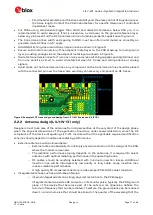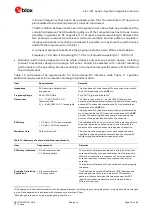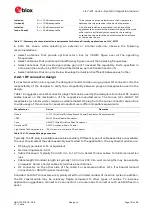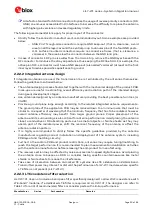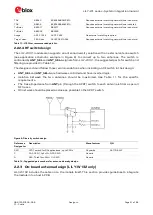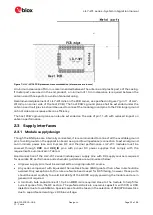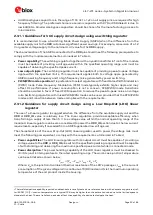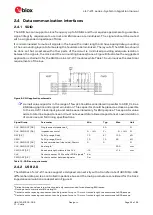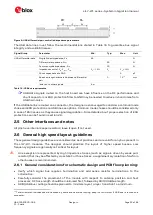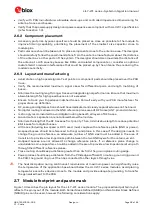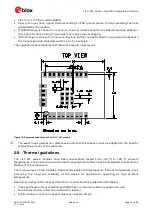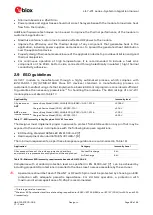
LILY-W1 series - System integration manual
UBX-15027600 - R09
System description
Page 13 of 64
C1 - Public
•
Allows card to interrupt host
Table 7 summarizes the bus speed modes supported by the module.
Bus Speed Mode
Max. Bus Speed [MB/s]
Max. Clock Frequency [MHz]
High Speed
25
50
Default Speed
12.5
25
Table 7: SDIO supported rates
Pull-up resistors are required for all SDIO data and command lines. These pull-up resistors can be
provided either externally on the host PCB or internally in the host application processor. Depending
on the routing of the SDIO lines on the host, termination resistors in series to the lines might also be
needed. See section 2.4.1 for more information.
Name
I/O
Description
Remarks
SD_CLK
I
SDIO Clock input
SD_CMD
I/O
SDIO Command line
External PU required
SD_D0
I/O
SDIO Data line bit [0]
External PU required
SD_D1
I/O
SDIO Data line bit [1]
External PU required
SD_D2
I/O
SDIO Data line bit [2]
External PU required
SD_D3
I/O
SDIO Data line bit [3]
External PU required
Table 8: SDIO signal definition
The module's SDIO host interface pins are powered by the
VCC_IO
voltage domain.
1.5.2
USB 2.0 interface
The USB device interface is compliant with the USB 2.0 Specification [6]
The main features of the
USB interface are:
•
High/Full speed operation (480/12 Mbps)
•
Suspend/host resume/device resume (remote wake-up)
•
Built-in DMA engine to reduce interrupt loads on embedded processor and optimize bus
bandwidth
•
Support for Link Power Management (LPM), corresponding host resume, or device resume
(remote wakeup) to exit from L1 sleep state.
Disturbance from the USB data signals routed on the host board can have influence on the RF
performance and additional filtering may be needed. See section 2.4.2 for more info.
Name
I/O
Description
Remarks
USB_DP
I/O
USB Serial Data +
Differential signal
USB_DN
I/O
USB Serial Data -
Differential signal
USB_VBUS_ON
I
USB VBUS reference
Connect to
VCC
through a 33 k
Ω
resistor
Table 9: USB signal definition
⚠
If the USB interface is selected, VCC_IO only supports 3.3 V nominal supply range and must be
tied to VCC.
The module's USB host interface pins are powered by the
VCC
voltage domain.

















